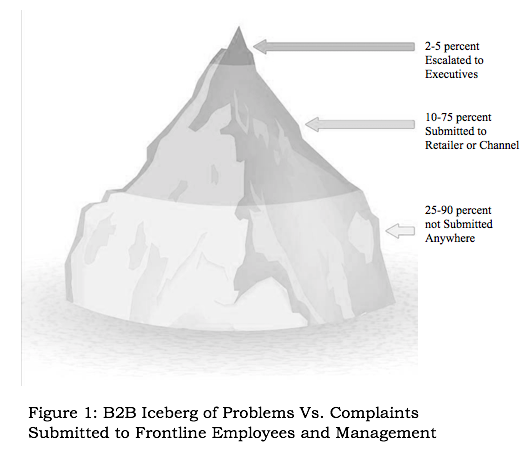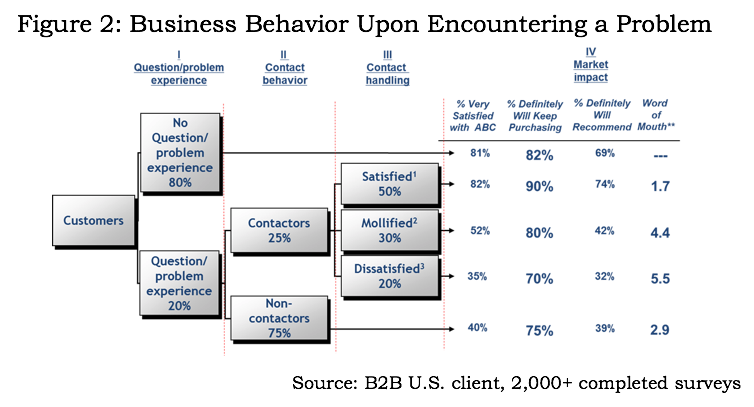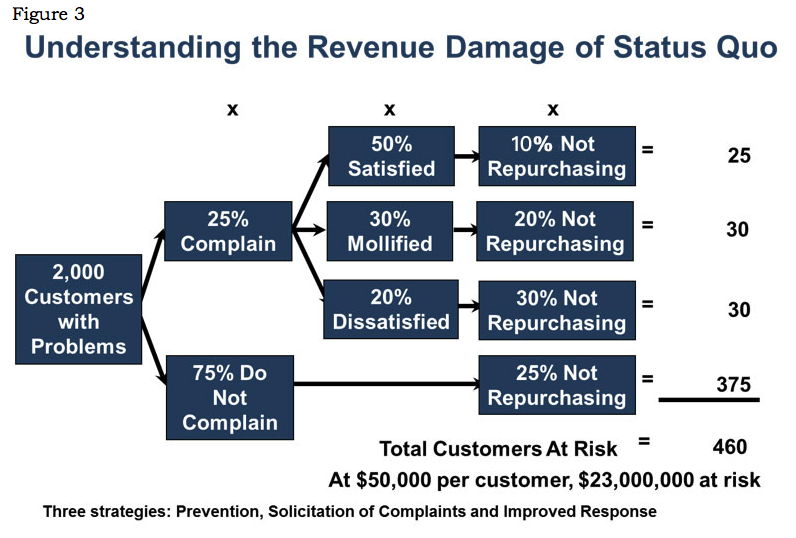Editor's note: John Goodman is vice chairman of Alexandria, Va.-based Customer Care Measurement and Consulting. He can be reached at jgoodman@customercaremc.com. David Beinhacker is the firm’s chief research officer. He can be reached at david@customercaremc.com.
We were recently talking with the principal of a business services company that we deal with and mentioned that we were not impressed with the service from the company’s receptionist. His reply was, “I’ve never heard any comments about her.” We suggested he ask the next 10 clients he talked to about her. A week later he called, much chastened. He reported that seven out of 10 customers queried had negative comments about the receptionist. He had taken action to fix the problem.
Unfortunately, every company in the B2B marketplace faces the same issue. Counterintuively, business customers often complain at a lower rate than consumers – so no news is not good news.
Why B2B customers do not complain
There are three major reasons why your business customers do not complain.
1. It won’t do any good. Businesss customers often feel that the “process is the process” and that the problem is just the way the company or even the entire industry does things. This perception is often reinforced by employees who lack training or empowerment. They will respond by saying, “Sorry that’s our policy,” which conveys nothing is going to change and there is no point in complaining.
We routinely ask employees how they justify onerous policies or procedures. More than half of the time employees indicate that they agree with the customer – they state that the policy is silly because they are not aware of why it is done. As a result, the employee apologizes to the customer while also suggesting that management doesn’t seem to understand or care.
2. It’s not that big of a problem and not worth the hassle. Often the problem is not huge but is a frustration and a time-waster. For instance, one insurance company found that benefits administration customers had difficulty printing their invoices which were needed for recordkeeping and tax purposes. Few had ever complained. However, an examination of call content found a myriad of requests for how to print invoices. When the link was put on the home page, it immediately went to No. 2 among all functions, being used hundreds of times per day.
3. Fear of conflict, retribution and damaging the relationship. This is probably the most insidious cause in that it is damaging but seldom complained about. In several business technology and services companies we’ve found that difficulties with sales, marketing and support representatives are much less frequently complained about than issues of product delivery or billing. The reason is that customers know they will be dealing with that person again in the near future and if they complain the next transaction will be much more uncomfortable.
Unarticulated dissatisfation
In consumer markets companies have long accepted that for every complaint received at its primary customer service touchpoint, a given business is also facing between five and 50 similar but unreported problems. However, few executives in the commercial and B2B environment have considered the iceberg of unarticulated dissatisfation. This iceberg multiplier is usually two to 10 problems for each complaint made to the primary touchpoint. However, if you are working through channels, this ratio can easily be five to 10 problems in the market per complaint you hear at HQ. This is because of channels filter issues, either by effectively handling the issue or, on occasion, simply blaming the supplier/parent company.

Figure 1 shows the results of over 500 B2B studies of B2B complaint behavior. These ratios are important because they allow an executive to estimate frequency of problems in the marketplace by extrapolating from the number of complaints.
Let’s look at an example. In four different copier and business technology sales and technical support environments, we found that less than 10 percent of B2B customers will complain about a service tech or relationship manager because they know they will have to depend upon that same person for future support! Further, customers who are in their twenties will often first go to the Web site to self-service, send an e-mail or chat but will seldom contact via an 800 number.
Measuring the impact
There are three measurable impacts of customers who have problems but do not complain: damage to loyalty and revenue, negative word of mouth and damage to margins. Figure 2 illustrates the potential behavior of many B2B customers. It is drawn from a business services environment (some numbers having been modified slightly).
Damage to revenue: Customers who perceive a problem with company products, policies and practices but do not complain are usually 20-to-30 percent less loyal and spread only ambivalent or negative word of mouth.
Damage to word of mouth: B2B customers may not complain but still spread negative word of mouth. In the example data below, dissatisfied customers spread the most negative word of mouth but those who do not complain still spread significant amounts of negative referrals to business associates. Some B2B companies acquire 90 percent of new customers via referrals so negative word of mouth can be deadly.

Damage to margin. When customers have problems, sensitivity to price increases. Our firm has found that in most environments when asked about value for price paid or satisfaction with price only about 10 percent of customers indicate dissatisfaction with price. The minute that a customer reports encountering one problem, sensitivity to price doubles. If multiple problems are encountered, sensitivity doubles again to 40-to-50 percent of customers. If you want to charge premium prices, focus on quality!
Leveraging the data
Looking to create the economic imperative for action? Quantify the cost of inaction for a month!
How is the data leveraged to get the attention of the CFO and the CMO? If you can quantify the number of customers at risk due to a month of poor service you assign a revenue cost/month of inaction. For each month we do not fix this issue, we will lose X customers worth Y in revenue, causing Z cases of negative word of mouth. Figure 3 shows how the behaviors in Figure 2 can be converted into revenue implications.

What shocks a CFO is the percentage of customers at risk who have not even bothered to call the company. Seventy-five percent of the $26 million at risk lies in non-complainers. As Figure 3 notes, there are three strategies for recouping the revenue: preventing problems, getting customers to complain and enhancing the effectiveness of the service process. In most companies, the real solution is a mix of the three strategies.
Implications and opportunities
Fortunately, customer non-complaint behavior and hesitancy to complain presents a number of opportunities, through innovation, to differentiate your company from the competition:
- Measure unarticulated problems. Execute a survey of a random sample of the full range of customers, not just key contacts but others that your company rountinely touches and who depend upon your company’s support. Ask if they have encountered problems they have not reported. Then measure their willingness to recommend you – you’ll usually see those with problems showing a 20 percent reduction in loyalty. Do not just survey decision-makers and those who contact for service. Go for other logical users and supervisors. We suggest a three-level sample with decision-makers, influencers and frontline employees. You will identify three completely different sets of problems and behaviors.
- Ask your employees to name three policies they are told to communicate to customers that cause frustration. Identify a way to mitigate or eliminate those frustration-causing “standard business practices.” If one of the policies cannot be changed, develop a clear, believeable explanation a layman would understand and accept. Test with 10 customers to be sure it makes sense to them. It will leave them at least molified and much less angry with your staff.
- Agressively solicit complaints. After you have given your staff the above response rules, train them to aggressively solicit complaints. Remember that most customers will not complain a second time when the first issue complained about wasn’t handled well. The solicitation should include overt questions, depending on the environment. A Web site banner can say, “We can only solve problems we know about! Service staff should ask, ‘Has this call completely satisfied your needs?’”
- Train your staff to recognize subtle complaints. When someone says as an aside, “By the way, he doesn’t return my calls quickly,” the worst thing the staff person can say is, “We hear that a lot.” Recognition of softly-presented problems requires careful listening, with a response like, “You sound dissatisfied, would you like me to look into this or tell the process or business executive?”
- Create a unified analysis process. Develop a process to combine and analyze complaints with your surveys and employee input. In many companies these three data sources provide radically different perspectives. Remember that each complaint can easily represent five or 10 customers with similar experiences. The critical output of such an analysis is the number of customers and revenue potentially at risk per month. Work with finance to be sure they accept the analysis.
Remember, it’s what you don’t hear that can cause the most damage.
